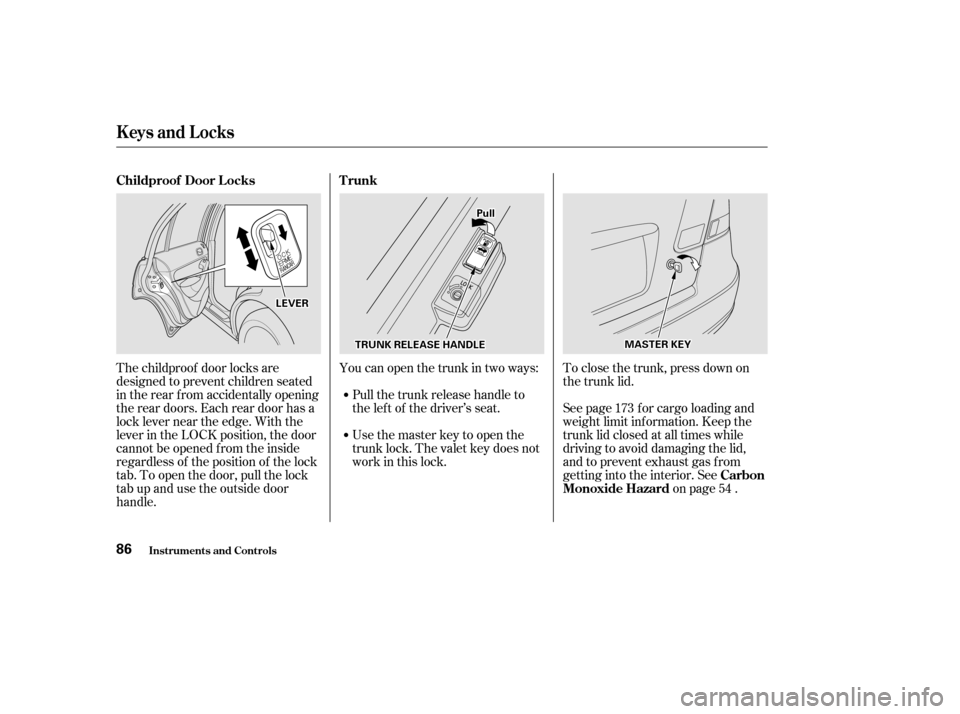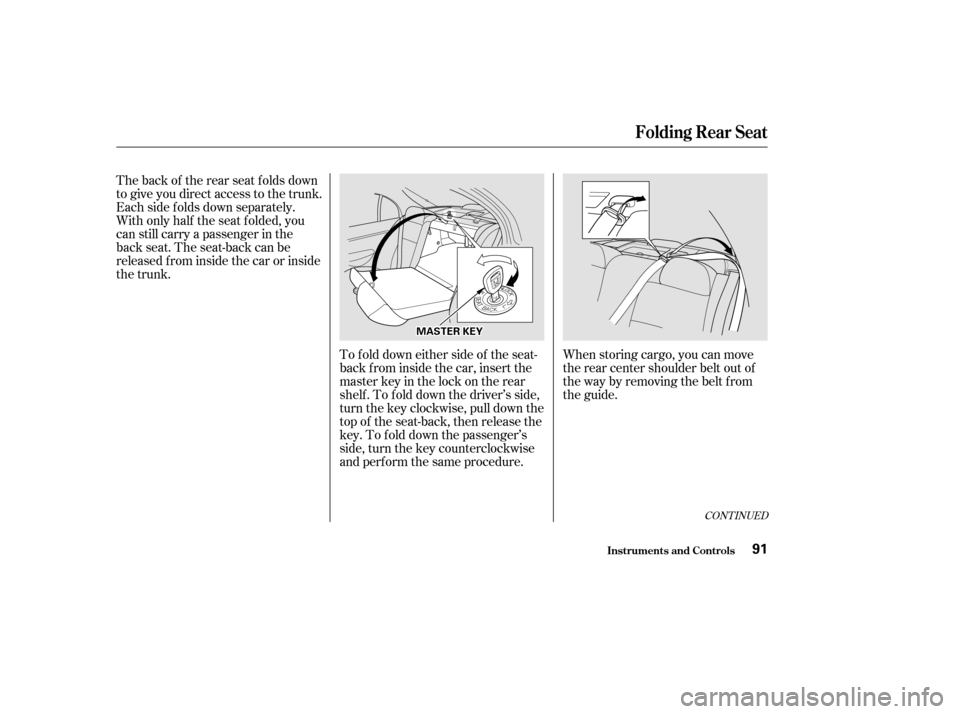2002 HONDA CIVIC trunk
[x] Cancel search: trunkPage 25 of 321

Even very young
children learn how to unlock
vehicle doors, turn on the ignition,
and open the trunk, which can
lead to accidental injury or death. Children
who play in cars can accidentally
get trapped inside the trunk.
Teach your children not to play in
or around cars. Know how to
operate the emergency trunk
opener (U.S. models only) and
decide if your children should be
shown how to use this f eature (see
page ).
Leaving children without
adult supervision is illegal in most
states and Canadian provinces,
and can be very hazardous. For
example, inf ants and small
childrenleftinavehicleonahot
day can die f rom heatstroke. And
children lef t alone with the key in the ignition can accidentally set
the vehicle in motion, possibly
injuring themselves or others.
Using this f eature will
prevent children f rom opening the
doors and accidentally f alling out
(see page ).
Using
this f eature will prevent children
f rom playing with the windows,
which could expose them to
hazards or distract the driver (see
page ).
Many parents say they pref er to put
an inf ant or small child in the f ront
passenger seat so they can watch the
child, or because the child requires
attention.
Placing a child in the f ront seat
exposes the child to hazards f rom
the passenger’s f ront airbag, and
paying close attention to a child
distracts the driver f rom the
important tasks of driving, placing
both of you at risk.
If a child requires physical attention
or f requent visual contact, we
strongly recommend that another
adult ride with the child in the back
seat. The back seat is far safer for a
child than the front.
87
86
94
Protecting Children
Driver and Passenger Saf ety
K eep car keys and remot e transmitters out of the reach ofchildren.
L ock all doors and t he t runk when
your vehicle is not in use.
Do not leave children alone in your vehicle.
Use childproof door locks t o
prevent children f rom opening t hedoors.
Use t he main power windowswit ch t o prevent children f romopening t he rear windows.
Additional Saf ety Precautions
If a Child Requires Close
Attention
26
Page 53 of 321

High levels of carbon monoxide can
collect rapidly in enclosed areas,
such as a garage. Do not run the
engine with the garage door closed.
Even with the door open, run the
engine only long enough to move the
vehicle out of the garage.
Your car’s exhaust contains carbon
monoxide gas. You should have no
problem with carbon monoxide
entering the car in normal driving if
you maintain your car properly.
Have the exhaust system inspected
f or leaks whenever:
The car is raised f or an oil change.
You notice a change in the sound
of the exhaust.
Thecarwasinanaccidentthat
may have damaged the underside. If you must sit in your parked car,
even in an unconf ined area, with the
engine running, adjust the heating
and cooling system as f ollows:
With the trunk lid open, air f low can
pull exhaust gas into your car’s
interior and create a hazardous
condition. If you must drive with the
trunk lid open, open all the windows
and set the heating and cooling
system as shown below.
Select the Fresh Air mode.
Select the mode.
Turn the f an on high speed.
Set the temperature control to a
comfortable setting.
1.2.3.4.
Carbon Monoxide Hazard
Driver and Passenger Saf ety54
Carbon monoxide gas is toxic.
Breathing it can cause
unconsciousness and even killyou.
Avoid any enclosed areas or
activities that expose you to
carbon monoxide.
Page 56 of 321

This section gives inf ormation about
the controls and displays that
contribute to the daily operation of
your Honda. All the essential
controls are within easy reach............................
Control Locations . 58
...............................
Indicator Lights . 59
.............................................
Gauges . 66
...............................
Speedometer . 66
.................................
Tachometer . 66
...............
Odometer/Trip Meter . 66
..................................
Fuel Gauge . 67
...................
Temperature Gauge . 68
Controls Near the Steering .......................................
Wheel . 69
...................................
Headlights . 70
............
Daytime Running Lights . 71
....
Instrument Panel Brightness . 71
................................
Turn Signals . 72
.....................
Windshield Wipers . 72
..................
Windshield Washers . 74
..........................
Hazard Warning . 74
.............
Rear Window Def ogger . 75
......
Steering Wheel Adjustment . 76
...............................
Keys and Locks . 77
..............................................
Keys . 77
....................
Immobilizer System . 78
............................
Ignition Switch . 80
..................................
Door Locks . 81
......................
Power Door Locks . 82
...................
Remote Transmitter . 83 ..............
Childproof Door Locks . 86
...........................................
Trunk . 86
........
Emergency Trunk Opener . 87
............................
Seat Adjustments . 88
.............
Front Seat Adjustments . 88
Driver’s Seat Height
..............................
Adjustment . 89
................
Driver’s Seat Armrest . 89
..........................
Head Restraints . 90
...........................
Folding Rear Seat . 91
..............................
Power Windows . 93
.........................................
Moonroof . 95
.............................................
Mirrors . 96
....
Adjusting the Power Mirrors . 96
.................................
Parking Brake . 97
........................................
Glove Box . 98
.............................
Beverage Holder . 99
.................
Console Compartment . 100
........................................
Coin Box . 101
...............................
Center Pocket . 101
.............
Accessory Power Socket . 101
...............................
Interior Lights . 102
..............................
Ceiling Light . 102
...................................
Spotlights . 103
..........................
Courtesy Light . 103
Instruments and Controls
Inst rument s and Cont rols57
Page 62 of 321

This light comes on with the high
beam headlights. See page for
inf ormation on the headlight
controls.
This lights when you set the cruise
control. See page f or inf ormation
on operating the cruise control.
On Canadian models, this indicator
comes on with reduced brightness
when the Daytime Running Lights
(DRL) are on (see page ).
See page .
The lef t or right turn signal light
blinks when you signal a lane change
or turn. If the light does not blink or
blinks rapidly, it usually means one
of the turn signal bulbs is burned out
(see page ). Replace the bulb as
soon as possible, since other drivers
cannot see that you are signalling. This light comes on if the trunk lid is
not closed tightly.
This light comes on as a reminder
that you must ref uel soon.
WhenyouturnontheHazard
Warning switch, both turn signal
lights blink. All turn signals on the
outside of the car should f lash. This light comes on when the
washer f luid level is low. Add washer
f luid when you see this light come on
(see page ).
70
71
281
248 159219
Only on models equipped with Cruise
Control System Canadian models only
High Beam Indicator
Cruise Control Indicator
Malf unction Indicator
Lamp
Turn Signal and
Hazard Warning
Indicators Low Fuel Indicator
Washer Level Indicator
Trunk-open Indicator
Indicator L ights
Inst rument s and Cont rols63
Page 76 of 321

CONT INUED
Your car comes with two master
keys and a valet key.
The master key fits all the locks on
your car:
Ignition
Doors
Trunk
Trunk release handle
Rear seat trunk accessThe valet key works only in the
ignition and the door locks. You can
keep the trunk, trunk release handle
and rear seat trunk access locked
when you leave your car and the
valet key at a parking f acility. (See
Trunk, page .)
Youshouldhavereceivedakey
number plate with your set of keys.
You will need this key number if you
ever have to get a lost key replaced.
Keep the plate stored in a saf e place.
When replacing keys, use only
Honda-approved key blanks.
These keys contain electronic
circuits that are activated by the
Immobilizer System. They will not
work to start the engine if the
circuits are damaged.
Protect the keys f rom direct
sunlight, high temperature, and
high humidity.
The keys do not contain batteries.
Do not try to take them apart. Keep the keys away f rom liquids.
If they get wet, dry them immedi-
ately with a soft cloth.
Donotdropthekeysorsetheavy
objects on them.
86
Inst rument s and Cont rols
Keys
Keys and Locks
77
KKEEYYNNUUMMBBEERRPPLLAATTEE
MMAASSTTEERRKKEEYYSS((BBllaacckk))
VVAALLEETTKKEEYY((GGrraayy))
Page 85 of 321

To close the trunk, press down on
the trunk lid.
See page f or cargo loading and
weight limit inf ormation. Keep the
trunk lid closed at all times while
driving to avoid damaging the lid,
and to prevent exhaust gas from
getting into the interior. Seeon page .
Youcanopenthetrunkintwoways:
Pull the trunk release handle to
the lef t of the driver’s seat.
Usethemasterkeytoopenthe
trunk lock. The valet key does not
work in this lock.
The childproof door locks are
designed to prevent children seated
in the rear f rom accidentally opening
the rear doors. Each rear door has a
lock lever near the edge. With the
lever in the LOCK position, the door
cannot be opened f rom the inside
regardless of the position of the lock
tab. To open the door, pull the lock
tab up and use the outside door
handle.
54
173
Keys and Locks
Inst rument s and Cont rols
Trunk
Carbon
Monoxide Hazard
Childproof Door L ocks
86
TTRRUUNNKKRREELLEEAASSEEHHAANNDDLLEEMMAASSTTEERRKKEEYY
LLEEVVEERR
PPuullll
Page 86 of 321

To protect items in the trunk when
you need to give the key to someone
else, lock the trunk release handle
with the master key and give the
other person the valet key.As a saf ety f eature, your car has a
release lever on the trunk latch so
the trunk can be opened f rom the
inside.Parents should decide if their
children should be shown how to use
this feature.
For more inf ormation about child
saf ety, see page .
To open the trunk, push the release
lever to the lef t. 26
U.S. models only
Keys and Locks
Inst rument s and Cont rols
Emergency T runk Opener
87
MMAASSTTEERRKKEEYY
Page 90 of 321

The back of the rear seat folds down
to give you direct access to the trunk.
Each side f olds down separately.
With only half the seat f olded, you
can still carry a passenger in the
back seat. The seat-back can be
released f rom inside the car or inside
the trunk.When storing cargo, you can move
therearcentershoulderbeltoutof
the way by removing the belt f rom
the guide.
To f old down either side of the seat-
back f rom inside the car, insert the
master key in the lock on the rear
shelf. To fold down the driver’s side,
turn the key clockwise, pull down the
top of the seat-back, then release the
key. To f old down the passenger’s
side, turn the key counterclockwise
and perf orm the same procedure.
CONT INUED
Folding Rear Seat
Inst rument s and Cont rols91
MMAASSTTEERRKKEEYY